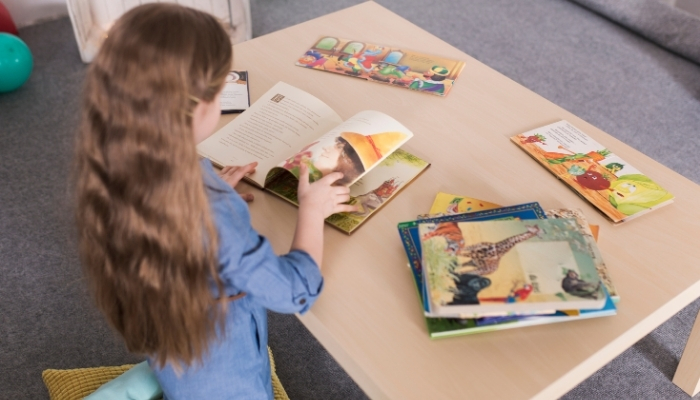Every child deserves that spark of pride when they read their very first sentence, and decodable readers help make that moment happen.
In kindergarten, children are just beginning to connect letters to sounds, and they need books that meet them exactly where they are. Decodable reading passages are designed for this purpose; they match what students are learning in phonics, helping them sound out words instead of guessing.
What’s even better? There are plenty of free decodable resources available today that parents and teachers can use to turn reading practice into a fun, confidence-boosting experience.
In this article, we’ll explore what decodable readers are, why they matter for kindergarteners, how to use them effectively, and where to find high-quality free resources to support your child’s reading journey. Let’s get started!
Quick Summary
-
Decodable readers help kindergarteners connect phonics learning with real reading practice.
-
Phonics-aligned passages strengthen decoding, fluency, and comprehension skills.
-
Free decodable reading resources are available online for both parents and teachers.
-
These books build confidence and independence, especially for struggling readers.
-
FunFox Readers Club reinforces phonics and early literacy through interactive, small-group lessons.
What Are Decodable Readers?
Decodable readers are short, phonics-based books designed to help children practice the sound-letter relationships they’ve already been taught.

Unlike traditional storybooks that include many unpredictable words, decodable readers use patterns children can decode independently, for example, “Sam sat on a mat.”
How They Work:
-
Each book focuses on a specific phonics skill (like short /a/ or consonant blends).
-
Sentences are structured for success, not guessing.
-
They let children connect phonics instruction to real reading.
Importance of Decodable Readers for Kindergarten
Decodable readers play a crucial role in helping kindergarteners transition from learning letter sounds to reading full sentences independently. They align with phonics instruction, giving children meaningful opportunities to practice decoding skills in a real context.
Why Decodable Readers Matter
-
Bridge Between Phonics and Reading: They help children apply letter-sound knowledge directly, turning theory into practice.
-
Boost Confidence Early: Success with simple, decodable words helps kids see themselves as capable readers.
-
Encourage Accuracy Over Guessing: Unlike predictable or picture-heavy books, decodable readers guide children to sound out each word correctly.
-
Build Foundational Fluency: Regular exposure strengthens recognition of letter patterns and common word families.
-
Support Differentiated Learning: Teachers and parents can select passages that match a child’s phonics level for personalised growth.
Also read: Reading Fluency and Comprehension: Strategies for Lifelong Literacy
Aligning Decodable Readers with the Phonics Sequence
Strong decodable reading materials are carefully aligned with a phonics sequence, meaning they follow the same logical order in which children are taught letter sounds. This alignment ensures that kids only read words containing sounds they’ve already learned, helping them experience success while strengthening foundational reading skills.
Here’s how Phonics Alignment supports learning:
-
Builds Step-by-Step Mastery: Students progress from simple sounds (like m, s, a, t) to complex patterns (like blends and digraphs).
-
Reinforces Classroom Instruction: Reading passages directly match what’s taught in phonics lessons, promoting consistency.
-
Reduces Cognitive Overload: Children aren’t overwhelmed by unfamiliar words; they read what they’re ready for.
-
Improves Accuracy and Retention: Familiar sound patterns lead to quicker word recognition and stronger memory recall.
-
Encourages Independent Reading: Aligned decodable texts empower children to practice confidently without constant adult help.
How to Use Decodable Readers Effectively
Decodable readers are most powerful when used regularly and intentionally. The goal is to get through a passage, and to help children connect sounds, build confidence, and enjoy the process of reading. Whether at home or in the classroom, short, focused sessions can make a big difference in developing strong reading habits.

Simple steps for effective use:
-
Start with the Right Level: Choose decodable readers that match your child’s current phonics knowledge. If they’ve just learned short vowel sounds, begin with simple CVC (consonant-vowel-consonant) words like cat or sit.
-
Sound It Out Together: Encourage your child to blend sounds slowly, “s-a-t… sat.” Avoid guessing; focus on hearing and connecting each sound to the right letter.
-
Reread for Confidence: Repetition builds fluency. Let your child reread the same passage several times to improve speed, accuracy, and expression.
-
Talk About the Story: After reading, ask gentle comprehension questions like “What happened first?” or “Who was in the story?” This helps children think beyond decoding.
-
Keep Sessions Short and Positive: Limit practice to 10–15 minutes a day. Praise their effort and progress; this positive reinforcement keeps them motivated to read more.
-
Combine with Playful Activities: Use FunFox’s printable games, letter tiles, or online phonics resources to reinforce the same sounds in different, engaging ways.
Benefits of Using Decodable Readers for Learning
Decodable readers do more than help children recognise words; they build confidence, fluency, and a lifelong love for reading. Because these books are structured around specific phonics skills, every success feels natural and rewarding for young learners.
Key benefits for kindergarten learners:
-
Builds a Strong Reading Foundation: Children apply phonics knowledge in real contexts, bridging the gap between recognising sounds and reading complete sentences.
-
Encourages Early Independence: By decoding familiar sound patterns, kids gain confidence to read on their own without constant adult support.
-
Improves Fluency and Accuracy: Regular reading of decodable texts helps children identify common words quickly and read with greater ease.
-
Strengthens Comprehension: As decoding becomes more automatic, children can focus on understanding and enjoying what they read.
-
Boosts Motivation and Confidence: Every small reading success reinforces the belief that “I can do this,” making reading feel enjoyable rather than intimidating.
-
Supports Consistent Learning: When parents and teachers use similar decodable materials, it ensures continuity between home and classroom practice.
Together, these benefits help children develop not just the skill to read, but the joy to keep reading.
Also read: Reading Checklist for Kindergarten to Help Your Child Get School-Ready
Free Decodable Reading Resources
You don’t need to buy expensive materials to help your child learn to read; there are plenty of free, high-quality decodable readers available online. These resources are designed by educators and literacy experts, making it easy for parents and teachers to find passages that match their students’ current phonics level.

Where to Find Free Decodable Readers
-
FunFox Readers Club: Offers free sample reading passages and activities aligned with the Australian curriculum, designed to make phonics practice interactive and engaging.
-
Flyleaf Publishing (Digital Library): A free collection of beautifully illustrated decodable books available online, perfect for classroom or home reading.
-
UFLI Foundations (University of Florida): Provides printable decodable passages and lesson plans that follow a structured phonics progression.
-
Teach Starter and Twinkl: Feature teacher-created decodable texts and phonics games that can be downloaded for classroom or at-home use.
-
Reading Rockets: Offers reading strategies, phonics activities, and links to free decodable passages tailored to early literacy development.
Using a mix of these resources ensures your child practices decoding across different formats, from print to digital, keeping learning fresh, consistent, and fun.
Helping Struggling Readers Thrive with Decodable Books
Decodable readers are especially helpful for struggling readers because they simplify the process, focusing on one phonics skill at a time. With the right support, patience, and encouragement, these learners can make steady, meaningful progress.
Ways to Support Struggling Readers
-
Start with Simpler Sounds: Go back to earlier phonics levels if needed. Revisiting foundational sounds helps rebuild confidence and accuracy.
-
Use Short, Consistent Practice: Instead of long reading sessions, aim for 10–15 minutes of focused daily practice with decodable passages.
-
Incorporate Multi-Sensory Learning: Combine reading with tracing, writing, or using letter tiles to reinforce sound-letter connections in a hands-on way.
-
Provide Positive Feedback:
Celebrate effort, not just accuracy. Encouragement keeps children motivated and helps reduce frustration. -
Pair with FunFox Readers Club: Our small-group lessons give children personalised attention and structured practice that builds both skills and confidence. Give your child the confidence to enjoy reading. Join the FunFox Readers Club today!
Final Words
Decodable readers are one of the most effective tools for helping young learners develop reading confidence. By matching each passage to the phonics skills children are learning, these books make reading achievable, rewarding, and fun. Every time a child sounds out a new word or completes a short story, they’re building not just literacy skills, but lifelong confidence.
FunFox takes this learning further with structured, small-group lessons that combine phonics, fluency, and comprehension in engaging ways. Children receive the personalised support they need to progress at their own pace while discovering the joy of reading.
Help your kindergartener turn early reading challenges into confidence and success. Join the FunFox Readers Club and start your reading adventure today!
FAQs
1. What are decodable readers?
Decodable readers are books designed to align with a child’s phonics knowledge. They use simple, controlled vocabulary so children can practice blending sounds and reading words they’ve already learned.
2. Why are decodable readers important in kindergarten?
They help children apply phonics in real reading situations, building accuracy, fluency, and confidence early in their learning journey.
3. How often should my child read decodable books?
Short, daily practice, about 10–15 minutes, is ideal. Regular reading builds consistency and helps new skills stick.
4. Can decodable readers help struggling readers?
Yes! Because they focus on specific sound patterns, decodable books allow children to experience success quickly, helping rebuild confidence and fluency over time.














